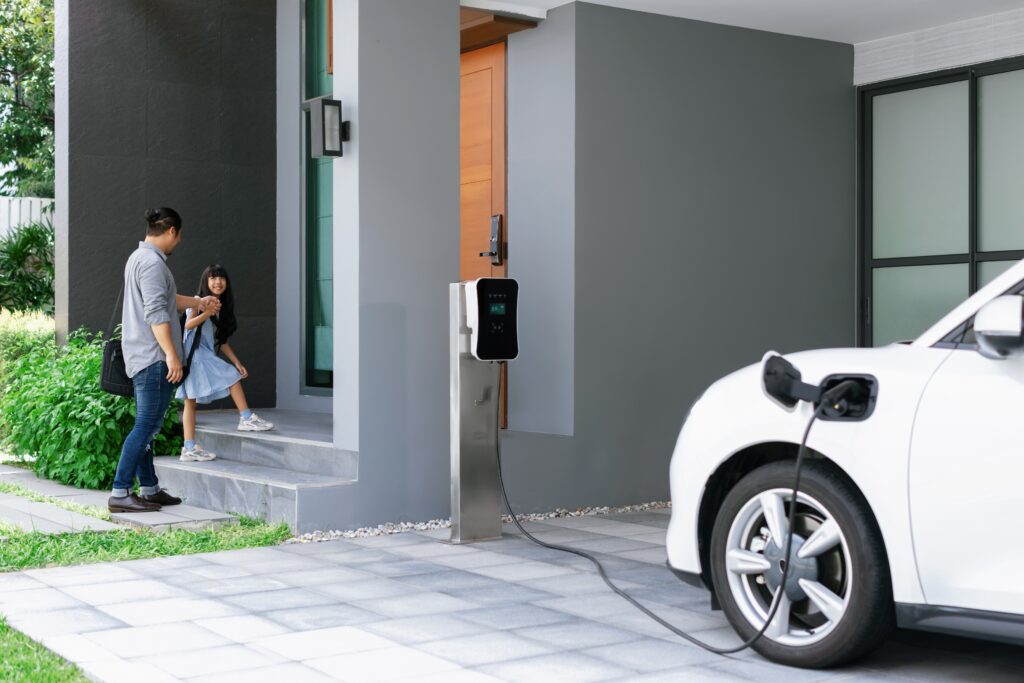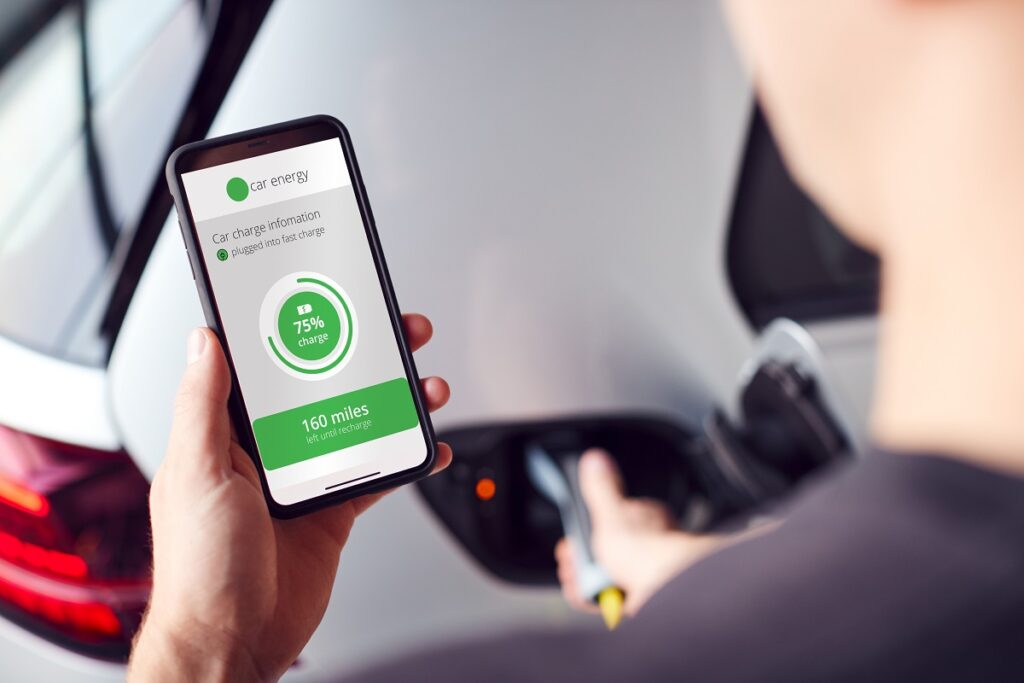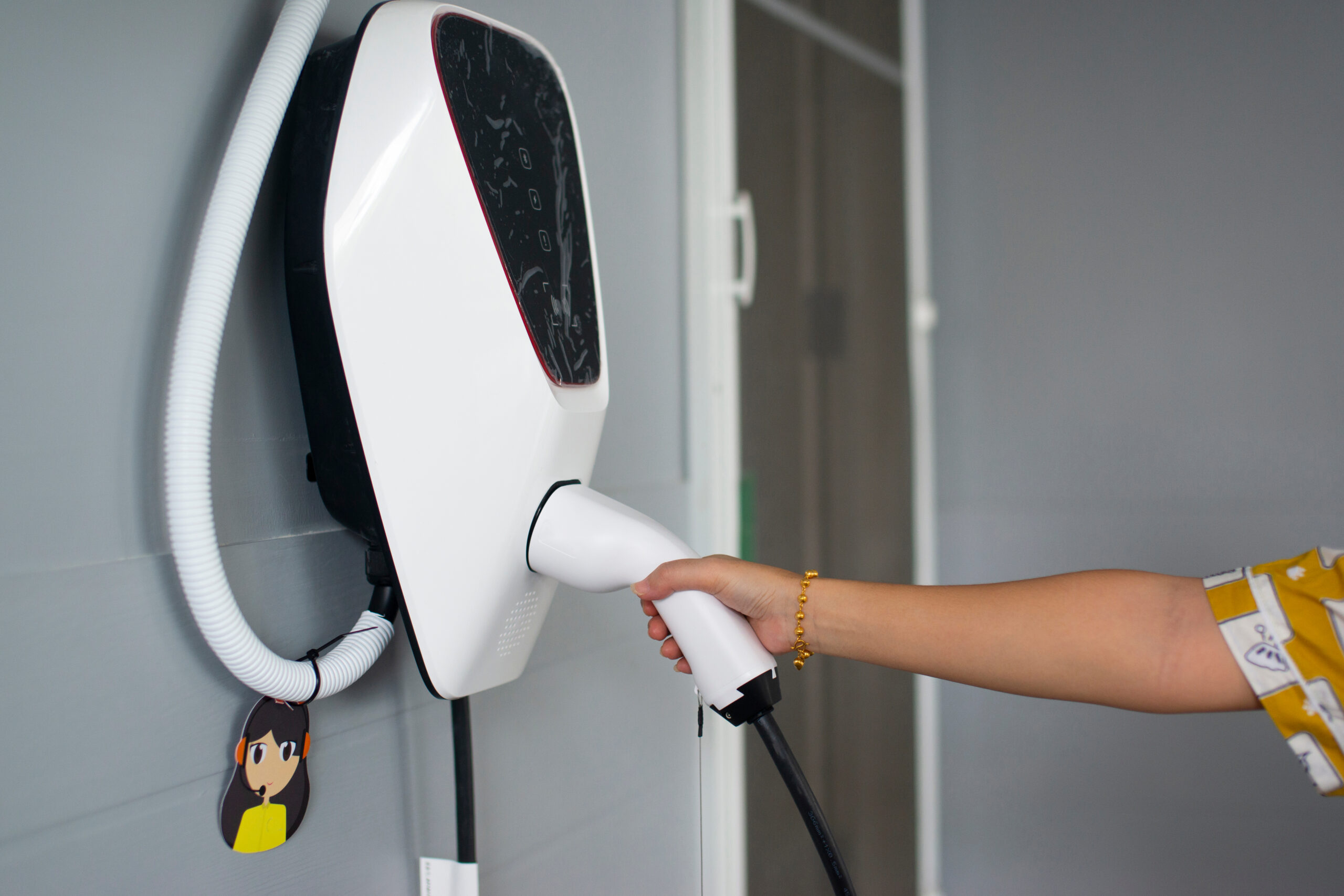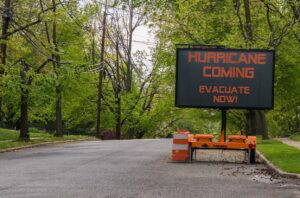Electric vehicles (EV) are quickly becoming mainstream. According to the Argonne National Laboratory, more than 3.4 million EVs are on American roads today, and they are expected to make up more than 50% of new vehicle sales by 2030. For many Americans, this may mean less time at the gas station and more time at the garage outlet.
What does this mean for the safety of your home (and your bank account)? We reached out to Sarah Ollila, program manager for the Vehicle Technologies Office (VTO) of the Department of Energy. Sarah answered six of the top questions homeowners have about EV chargers at home and how to stay safe while using one.
Are all EV chargers the same?
The short answer is no. There are three types of EV chargers: Level 1, Level 2, and DC Fast Charging (or Level 3).
Level 1 charger
The first type, a Level 1 charger, is the most common EV car charger.
“Most, if not all, EVs come with a Level 1 charging cord, which plugs directly into a normal, 120-volt wall outlet,” says Sarah, who has been with the DOE for more than eight years. “It’s just like charging your phone.”
Level 1 chargers replenish an EV’s battery at a rate of five miles per hour of charging in a 120-volt outlet.
“If you charge for eight hours overnight, that would be about 40 miles of electric range for a standard mid-size EV,” says Sarah. “If you want to get more charging in during that time, you could use what they call a Level 2 charger.”
Level 2 charger

Level 2 EV chargers are best known as the ones in the charging stations you see in your local grocery store or strip mall parking lot. This type of charger typically yields 25 miles per hour of charging and requires professional installation and a 240-volt outlet (the same outlet as a clothes dryer). Sometimes, upgrades to a home’s electrical system are needed prior to installation.
DC Fast charging station
A third type of EV charger, a “DC Fast Charging” equipment or Level 3 EV charger, can have a power output over 350kW, allowing it to charge a standard electrical car in 60 minutes or less. Currently, there are just under 7,000 of public stations across the U.S. At this time, DC chargers cannot easily be installed in homes and would require expensive structural upgrades, upwards of $50,000, to complete.
Please note: Tesla vehicles require an adapter to connect to non-Tesla charging stations. (These are generally provided at time of purchase.) Likewise, non-Tesla cars need an adapter to use Level 1 or 2 Tesla charging stations; however, non-Tesla cars cannot use Tesla Superchargers (or Tesla Level 3 EV chargers).
How do you know which EV charger is right for you?
“Some people are surprised to find that the average vehicle miles traveled per day is actually fairly low,” says Sarah, who helps to accelerate the development of clean transportation solutions. “To go to work, to the grocery store, and to drop the kids off at school is probably going to be less than 40 miles a day.”
If you and your family travel further or you have a longer commute, you may need to upgrade to a Level 2 charger.
Do you really save money on transportation costs with an EV?
With gasoline prices still lingering above $3 a gallon in most parts of the U.S., the price of electric car charging is much cheaper.
“It depends on the electricity costs of where you’re located,” says Sarah, as utility rates vary from state to state, “but one of the nice things about charging at home is that you take advantage of lower over-night electric rates.”
These rates average 16 cents a kilowatt-hour (kW), which means a full-charge of an EV battery costs around $15. A 12-gallon tank of gas in the U.S. is about $41 (currently).
“It’s considerably less expensive than refilling your fuel tank with gasoline,” says Sarah.
Also, more than 25% of public EV charging stations are free to use, according to the Alternative Fuels Data Center. Of course, the purchase price of an EV can be significantly higher than a gas-powered vehicle, and Level 2 EV chargers have upfront and installation costs, too.
Before you buy an EV or install a Level 2 charger, research federal, state, and utility incentives. You may be surprised by offers that may help bring down the costs of both the purchase of an EV and the installation of Level 2 charger.
How hard is it to install a Level 2 charger for home?

-
- Determine where you’d like the charger installed.
- Hire a professional electrician with experience in EV charger installation.
- Obtain the necessary permits. (Your electrician should be able to help with this.)
- Schedule installation.
- Have the EV home charger installed.
Most Level 2 chargers are installed in a garage, but they can also be installed outside your home.
“If you’re going to do an outdoor installation, think about where you want to park relative to the outlet,” says Sarah.
Some Level 2 chargers sit on a pedestal while some attach to the wall. All have standard safety features, including being UL-certified. Some have advanced features, such as data collection and expansive user displays.
As mentioned earlier, charging an EV at home with a Level 2 charger requires a 240-volt system. Most homes already have this system since dryers and electric stoves require them, but you may need to have that outlet installed where you park (and charge) your car. The DOE recommends using a licensed electrician to install the 240-volt outlet and the charger itself.
“There are different types of outlet prong configurations that you can get,” says Sarah, “so you do need to make sure that the outlet you install matches the charger you purchased. An electrician can help do that.”
One of the best ways to find an electrician who specializes in EV charger installation is to contact your EV dealer.
“Manufacturers and dealerships are starting to get more involved,” says Sarah. “It’s possible some of them might even offer charger installation as an incentive to purchase an EV.”
Your local building authorities may require a permit, and while your professional electrician should be able to help, you can learn more about the codes and standards on the Alternative Fuels Data Center website.
What do you need to know to charge your car at home?

Once you have your EV or new charging station, you’ll want to make sure you’re charging safely. Before you plug in your car, here are answers to frequently asked questions that Sarah sees at the VTO:
-
- When using a Level 1 charger, use a GFCI outlet to charge.
-
- Car orientation and surface level (such as a flat surface) matter little.
-
- Charging in the rain is just as safe as charging in dry weather.
-
- Be mindful of where you place the cord, so no one trips over it.
-
- If it’s not safe to charge, the EV and the charger will not allow a charging session to start.
If charging doesn’t start, it could be that the cord has been damaged, or there’s a short in the electrical circuit. Homeowners should be able to troubleshoot the situation easily.
“Many Level 2 chargers have displays or indicator lights that will give you some indication of where the error is, whether it’s on the vehicle or charger side,” says Sarah.
Depending on the reading, you can either reach out to the charger retailer or the dealer for a repair or replacement of that equipment.
Is there any maintenance required for EV chargers at home?
The good news is – home EV chargers require minimal maintenance.
“It mainly includes storing the charging cables securely, checking the parts periodically, and making sure that you haven’t run it over with a lawnmower,” says Sarah.
Homeowners should also keep the equipment clean by wiping it down every so often.
While the idea of plugging in a car may be new, homeowners will soon treat the whole process as second nature.
“Once you make the switch to an EV and get the home charging set up, it’ll really quickly become normal, just like plugging your phone in before bed,” says Sarah. “You won’t spend more time thinking about it than anything else.”
Take care of your home
Homeownership can be hard, but it doesn’t have to be. The vipHome.app can help. In less than four minutes, enjoy a new way to manage your home. Simply download the app, register your home, and enjoy a simplified homeownership experience.






